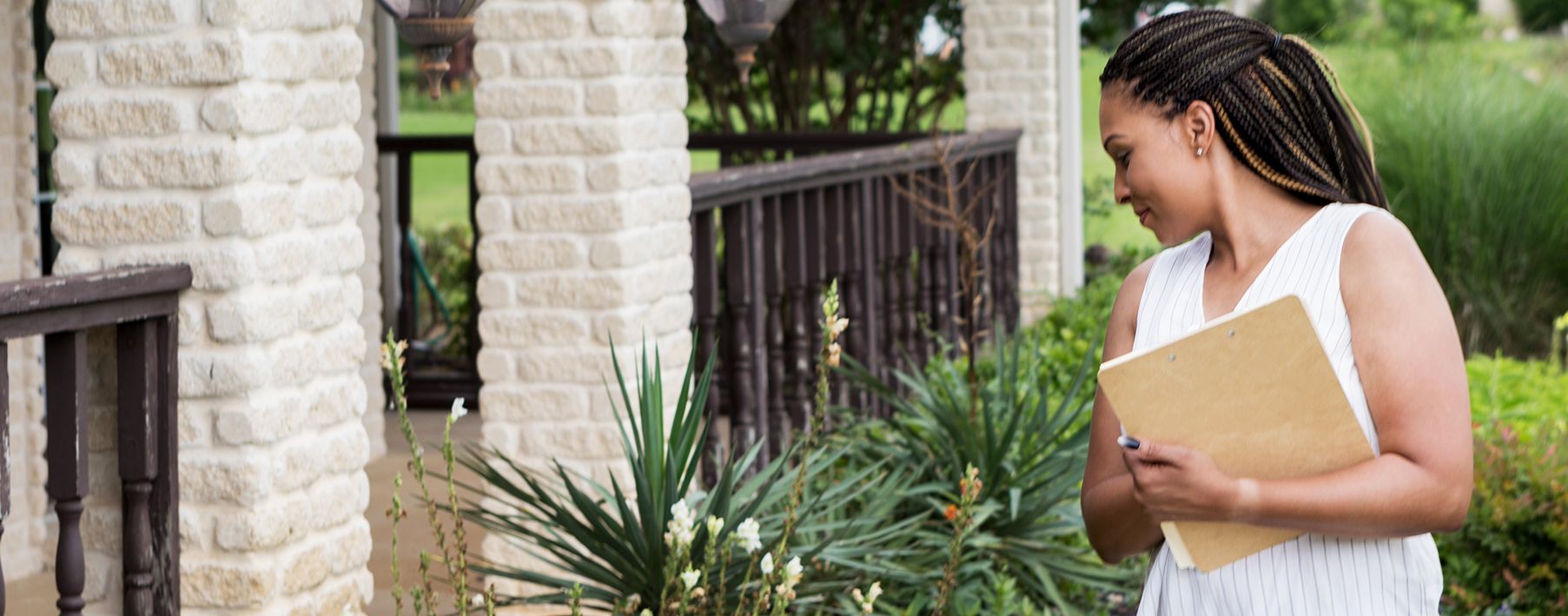What to Expect from a Home Insurance Inspection [Prepare Now]

Your insurer may require a home insurance inspection when you buy a home insurance policy. During this inspection, a representative from the company will visit your property to verify the information provided in your application. They will assess the condition of your home and identify any potential risks or hazards.
An inspection is a regular part of buying home insurance. But if you’re in a hurry, look for providers that use technology to speed up inspections. At Hippo, we use data to verify some items' value and condition beforehand to save you time.
No matter which company you choose, here’s what to expect in a home insurance inspection.
Key takeaways
- Home insurance inspections have two purposes: to appraise your home's replacement cost accurately and to identify any existing risks you need to address.
- There are three main types of home inspections: interior, exterior and four-point inspections.
- The age of your home and its location determine what type of home inspection your insurance provider requires, if any.
- Your home insurance rates can go up or down after an insurance inspection. In some cases, you might be denied coverage altogether.
- Homeowners insurance inspections are typically free.
What is a home insurance inspection?
A home insurance inspection is an assessment conducted by an insurance company to evaluate the condition and safety of a property before issuing a home insurance policy. This inspection helps the insurer assess the risk associated with insuring the home and determine the appropriate coverage and premiums.
The process of inspecting your home could be as simple as driving by it and taking a few photos of the exterior, or it could involve a more in-depth inspection of its electrical and plumbing systems.
Unlike a standard home inspection, which is arranged by the buyer or seller during the purchasing process, the insurance company initiates a home insurance inspection.
Home insurance inspection | Regular home inspection |
|---|---|
Used to determine home insurance coverage and premiums | Used to inform buyers about a property before purchasing |
May be less thorough than a regular inspection | Typically more comprehensive and detailed than a home insurance inspection |
Typically free | Paid for by the buyer or seller |
Why do insurance companies require home inspections?
Home insurance inspections help insurers assess the risk associated with insuring a property. It allows them to identify potential hazards that could lead to future claims, such as outdated electrical systems, damaged roofs, or structural problems.
Insurers also use home insurance inspections to verify the accuracy of the information you provided during the application process.
Inspections aren’t always required, but if you’re wondering, “Why does my insurance company want to inspect my house?” it might be because:
- You live in an older home
- You haven't had a home inspection in the past ten years
- You’ve recently renovated your home
- You’re switching to a new insurance carrier
- Your insurance company can’t determine the replacement cost value of your home
What to expect during a home insurance inspection
Though welcoming a stranger into your home to perform an insurance inspection may not be your idea of a good time, it's necessary if you want your policy to accurately reflect the current value and condition of your home. Think of it like getting your new engagement ring appraised so you can replace it should it ever fall off your finger.
So, what should you expect during a home insurance inspection? First, your insurance company will likely schedule it within 30 to 90 days of your policy application (depending on your location).
The inspection process takes anywhere from 30 minutes to a few hours, depending on the type of inspection scheduled.
During this time, your home inspector will look for potential risks not clearly listed on your application. They'll also adjust your policy if the estimated replacement cost should be adjusted.
Types of home inspections
Just as there are several types of homeowners insurance, there are also several types of homeowners insurance inspections:
- Interior inspections for the inside of your home
- Exterior inspections for the outside of your home
- Four-point inspections for the four major systems in your home
With all types of insurance inspections, your inspector will look for any hazards or risks your home presents. The age, size, location and cost of your home can all affect the outcome of your inspection. As a result, your current home inspection may differ from your last.
What do insurance companies check for in interior inspections?
If you’re buying a newer home, you may not have to undergo an interior insurance inspection. But for older homes, they're usually required to determine the home's current condition and whether any systems need to be replaced.
In addition to determining your home’s replacement costs, home inspectors will also look for defects or damage to your home, including:
- Electrical systems
- HVAC system unit
- Interior walls
- Plumbing
- Staircase
The insurance inspector will also note how you care for your property. Insurers refer to this as “pride of ownership.” Insurers want to know that you’re doing your part to prevent losses, which means having fire alarms, carbon monoxide detectors, security systems and anti-theft devices in place.
If you don’t have these devices installed already, don’t fret. Some insurance providers (like Hippo) will offer smart home monitoring kits. What’s inside these kits may vary, but they’re usually based on the latest smart home trends.
What do insurance companies check for in exterior inspections?
The most common type of homeowners insurance inspection is the exterior inspection.
You don't have to be home for this inspection, but knowing what your insurance company will look for is still a good idea. The inspector will likely take pictures and detailed notes about the condition of your:
- Chimney
- Exterior walls
- Roof
- Siding and/or paneling
- Yard
- Additional structures such as sheds, fences or detached garages
Another major part of home insurance inspections is pest control. Your inspector looks for any signs of previous pest damage (rodents, termites, etc.) and potential breeding areas.
Areas where water pools near the home or any cracks in the structure can be red flags to insurance providers, so make sure to take care of those issues beforehand to keep your insurance rates low.
Related: Does homeowners insurance cover fences?
What do insurance companies check for in four-point inspections?
Four-point home insurance inspections focus on your roof, plumbing, electrical and HVAC systems. These are the four main areas of your home that inspectors basically look at during inspections for insurance.
While they're included in interior and exterior inspections, these four areas are the most likely to cause high-claim payouts later on (and, therefore, require a more in-depth inspection).
What do home insurance inspectors look for?
Home insurance inspections have two purposes: to appraise your home’s replacement cost accurately and to identify any existing risks you need to address.
If there is existing damage to your home that could affect potential claims down the line, your home insurance may update your policy to reflect that.
Likewise, if the insurance inspection report indicates your home is at a higher risk for certain disasters than what you listed in your application, you may be required to get flood insurance or catastrophe insurance for additional protection.
To help avoid any changes in your policy, it’s best to prepare the inside and outside of your home for an upcoming inspection.
How to prepare for a home insurance inspection
Before getting your home inspected for insurance, it’s a good idea to go through and repair any issues that may catch an inspector’s eye.
You may have caught many of these issues through your monthly home maintenance checklist. But if this is a new home or you haven’t checked out your home in a bit, here’s a quick list of things to be on the lookout for depending on the type of inspection you have scheduled:
Preparing for an interior home inspection
You can prepare for an interior home insurance inspection by completing these tasks:
- Buy a fire extinguisher if you don’t have one already
- Check smoke detectors and replace batteries if needed
- Clean out the fireplace
- Empty dryer vent
- Seal leaks in your attic or basement
- Unclog backed-up drains
Preparing for an exterior home inspection
You can prepare for an exterior insurance inspection by tidying up the outside of your home and any additional structures on your property. This includes:
- Clear gutters of any debris
- Clean your fireplace flue
- Get HVAC and plumbing systems serviced
- Remove any standing water
- Seal and paint any cracks
- Spray for bugs
- Trim overhanging tree limbs
The cost of home inspections
Home insurance inspections are usually free, so you shouldn’t have to pay anything out of pocket. But if you live in an area prone to hurricanes or strong windstorms, you may need a special wind mitigation inspection. The homeowner usually pays for this inspection, which can cost around $125.
That said, the cost may be worth it. A wind mitigation inspection can save you up to 55% on home insurance if you’ve installed hurricane-rated doors and other measures made to withstand strong winds.
What to do after a failed homeowners insurance inspection
If you fail a home insurance inspection, there may be steps you can take to rectify the issues and keep your coverage. Here’s what to do.
- Review your home insurance inspection report. This should tell you specifically what issues led to the failure and how long you have to fix those issues.
- Address the issues identified in the report. This may include fixing plumbing problems that have led to water damage, replacing an old roof with missing shingles, or installing safety features like smoke detectors or handrails.
- Request a reinspection. Once you’ve fixed the issues, contact your insurance company for a reinspection.
If your report identifies issues that are expensive to repair, focus on fixing the most critical issues that directly impact your home’s safety or structural integrity. You can also explore financing options like home improvement loans, personal loans or government grants to get the funds you need.
If you can't immediately make all the requested changes, be upfront with your insurance company. They may be willing to work with you while you address the issues. If not, shop around for a new insurance company. Some may offer insurance to higher-risk homes.
Can I get home insurance without an inspection?
In some cases, you don’t need an inspection for homeowners insurance. For instance, if your home is brand new, has had an inspection recently, or is in a low-risk location, your insurance provider may not always require it.
Some home insurance companies require an inspection, no matter what. If you’re curious, call any providers you’re considering and ask about their best practices before you apply. You can even ask for a home insurance inspection checklist so you know what to expect.
If your provider requires an inspection for insurance, they’ll likely send someone on their own that they have worked with before. You’re more than welcome to get a second opinion, though you’d be on the hook for paying for the extra inspector. However, many insurance companies require a licensed professional.
If the insurance inspection doesn’t reveal anything unexpected, your policy should remain active.
Should an inspector find anything of concern, they’ll send a report to your provider and walk you through the next steps (which can involve mandatory repairs or a change in your coverage). Most providers will work with you to ensure you’re fully protected.
Still have questions?
Still have a pressing question about home insurance inspections? Speak with a Hippo specialist who can address your concerns about how inspection reports can affect your final home insurance policy. We’re here to make the process easy. In the meantime, here are some frequently asked questions about home insurance inspections.
Can my homeowners insurance be canceled after an inspection?
Yes, your home insurance company can cancel your coverage if you fail your inspection. You can do a few things if this happens, including fixing any issues your inspector pointed out, finding a different insurer, or disputing the decision if you have evidence to support your case.
Can my home insurance rate change after an inspection?
Your home insurer can adjust your premiums up or down based on what they find during your home insurance inspection. For instance, you may see your premiums drop if your replacement cost value is lower than expected or if you qualify for certain discounts—like living in a gated community or having a security system.
How long does a home insurance inspection take?
A home insurance inspection can take anywhere from 30 minutes to a few hours, depending on the type of inspection. You usually don't need to be home if it's just an exterior inspection. But if an interior inspection is required, you'll need to be home to let the insurance inspector inside.
Is a home inspection done when buying home insurance?
Yes, a homeowners insurance inspection may be required when you purchase a policy. This inspection is completely separate from the inspection you have done when you purchase a home. Insurance inspections aren’t always required, but you may need one if you live in an older home, it’s been at least ten years since you’ve had an inspection, or your insurer can’t verify your home’s replacement cost value.
What are the consequences of failing an insurance inspection?
There’s a chance your home insurance policy could be canceled if you fail an insurance inspection. If this happens, your insurance company should explain why it failed. If it’s because your home needs repairs (such as a new roof or electrical system), fixing these issues within the specified time frame may help you keep your policy. But if you don’t fix the issues or your policy is canceled for reasons outside your control (such as living in an area prone to too many natural disasters), you may need to seek other solutions, such as state-run insurance.
How often do insurance companies inspect homes?
It’s up to your insurer how often they perform home insurance inspections. Some will do exterior inspections at least every one to five years to make sure you’re keeping up with your home. Interior inspections may happen every ten years or so, if at all.



